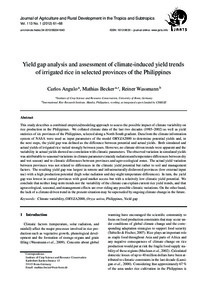Aufsatz

Yield gap analysis and assessment of climate-induced yield trends of irrigated rice in selected provinces of the Philippines
Zusammenfassung
This study describes a combined empirical/modeling approach to assess the possible impact of climate variability on rice production in the Philippines. We collated climate data of the last two decades (1985-2002) as well as yield statistics of six provinces of the Philippines, selected along a North-South gradient. Data from the climate information system of NASA were used as input parameters of the model ORYZA2000 to determine potential yields and, in the next steps, the yield gaps defined as the difference between potential and actual yields. Both simulated and actual yields of irrigated rice varied strongly between years. However, no climate-driven trends were apparent and the variability in actual yields showed no correlation with climatic parameters. The observed variation in simulated yields was attributable to seasonal variations in climate (dry/wet season) and to climatic differences between provinces and agro-ecological zones. The actual yield variation between provinces was not related to differences in the climatic yield potential but rather to soil and management factors. The resulting yield gap was largest in remote and infrastructurally disfavored provinces (low external input use) with a high production potential (high solar radiation and day-night temperature differences). In turn, the yield gap was lowest in central provinces with good market access but with a relatively low climatic yield potential. We conclude that neither long-term trends nor the variability of the climate can explain current rice yield trends and that agroecological, seasonal, and management effects are over-riding any possible climatic variations. On the other hand the lack of a climate-driven trend in the present situation may be superseded by ongoing climate change in the future.
Zitierform
In: Journal of Agriculture and Rural Development in the Tropics and Subtropics. Kassel : Kassel University Press. - Vol. 113, No. 1 (2012), S. 61-68Sammlung(en)
Vol 113, No 1 (2012) (Journal of Agriculture and Rural Development in the Tropics and Subtropics (JARTS))Zitieren
@article{urn:nbn:de:hebis:34-2012082241643,
author={Angulo, Carlos and Becker, Mathias and Wassmann, Reiner},
title={Yield gap analysis and assessment of climate-induced yield trends of irrigated rice in selected provinces of the Philippines},
year={2012}
}
0500 Oax 0501 Text $btxt$2rdacontent 0502 Computermedien $bc$2rdacarrier 1100 2012$n2012 1500 1/eng 2050 ##0##urn:nbn:de:hebis:34-2012082241643 3000 Angulo, Carlos 3010 Becker, Mathias 3010 Wassmann, Reiner 4000 Yield gap analysis and assessment of climate-induced yield trends of irrigated rice in selected provinces of the Philippines / Angulo, Carlos 4030 4060 Online-Ressource 4085 ##0##=u http://nbn-resolving.de/urn:nbn:de:hebis:34-2012082241643=x R 4204 \$dAufsatz 4170 7136 ##0##urn:nbn:de:hebis:34-2012082241643
<resource xsi:schemaLocation="http://datacite.org/schema/kernel-2.2 http://schema.datacite.org/meta/kernel-2.2/metadata.xsd"> 2012-09-24T11:30:52Z 2012-09-24T11:30:52Z 2012 1612-9830 urn:nbn:de:hebis:34-2012082241643 http://hdl.handle.net/123456789/2012082241643 eng Kassel University Press Urheberrechtlich geschützt https://rightsstatements.org/page/InC/1.0/ climate variability ORYZA2000 Oryza sativa Philippines yield gap 630 Yield gap analysis and assessment of climate-induced yield trends of irrigated rice in selected provinces of the Philippines Aufsatz This study describes a combined empirical/modeling approach to assess the possible impact of climate variability on rice production in the Philippines. We collated climate data of the last two decades (1985-2002) as well as yield statistics of six provinces of the Philippines, selected along a North-South gradient. Data from the climate information system of NASA were used as input parameters of the model ORYZA2000 to determine potential yields and, in the next steps, the yield gaps defined as the difference between potential and actual yields. Both simulated and actual yields of irrigated rice varied strongly between years. However, no climate-driven trends were apparent and the variability in actual yields showed no correlation with climatic parameters. The observed variation in simulated yields was attributable to seasonal variations in climate (dry/wet season) and to climatic differences between provinces and agro-ecological zones. The actual yield variation between provinces was not related to differences in the climatic yield potential but rather to soil and management factors. The resulting yield gap was largest in remote and infrastructurally disfavored provinces (low external input use) with a high production potential (high solar radiation and day-night temperature differences). In turn, the yield gap was lowest in central provinces with good market access but with a relatively low climatic yield potential. We conclude that neither long-term trends nor the variability of the climate can explain current rice yield trends and that agroecological, seasonal, and management effects are over-riding any possible climatic variations. On the other hand the lack of a climate-driven trend in the present situation may be superseded by ongoing climate change in the future. open access In: Journal of Agriculture and Rural Development in the Tropics and Subtropics. Kassel : Kassel University Press. - Vol. 113, No. 1 (2012), S. 61-68 Angulo, Carlos Becker, Mathias Wassmann, Reiner Gedruckte Ausg. im Verlag Kassel Univ. Press (www.upress.uni-kassel.de) erschienen. </resource>
Die folgenden Lizenzbestimmungen sind mit dieser Ressource verbunden:
Urheberrechtlich geschützt

